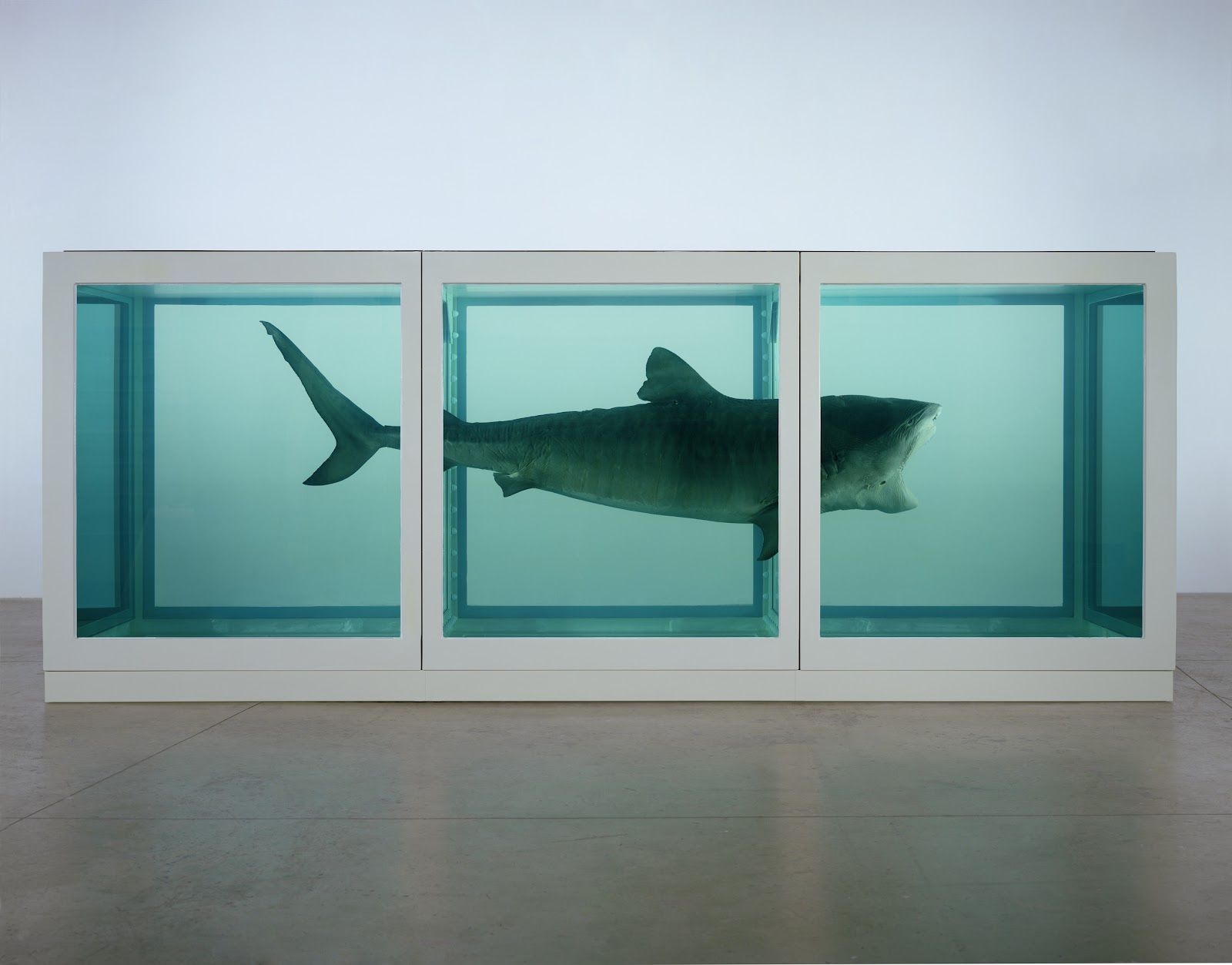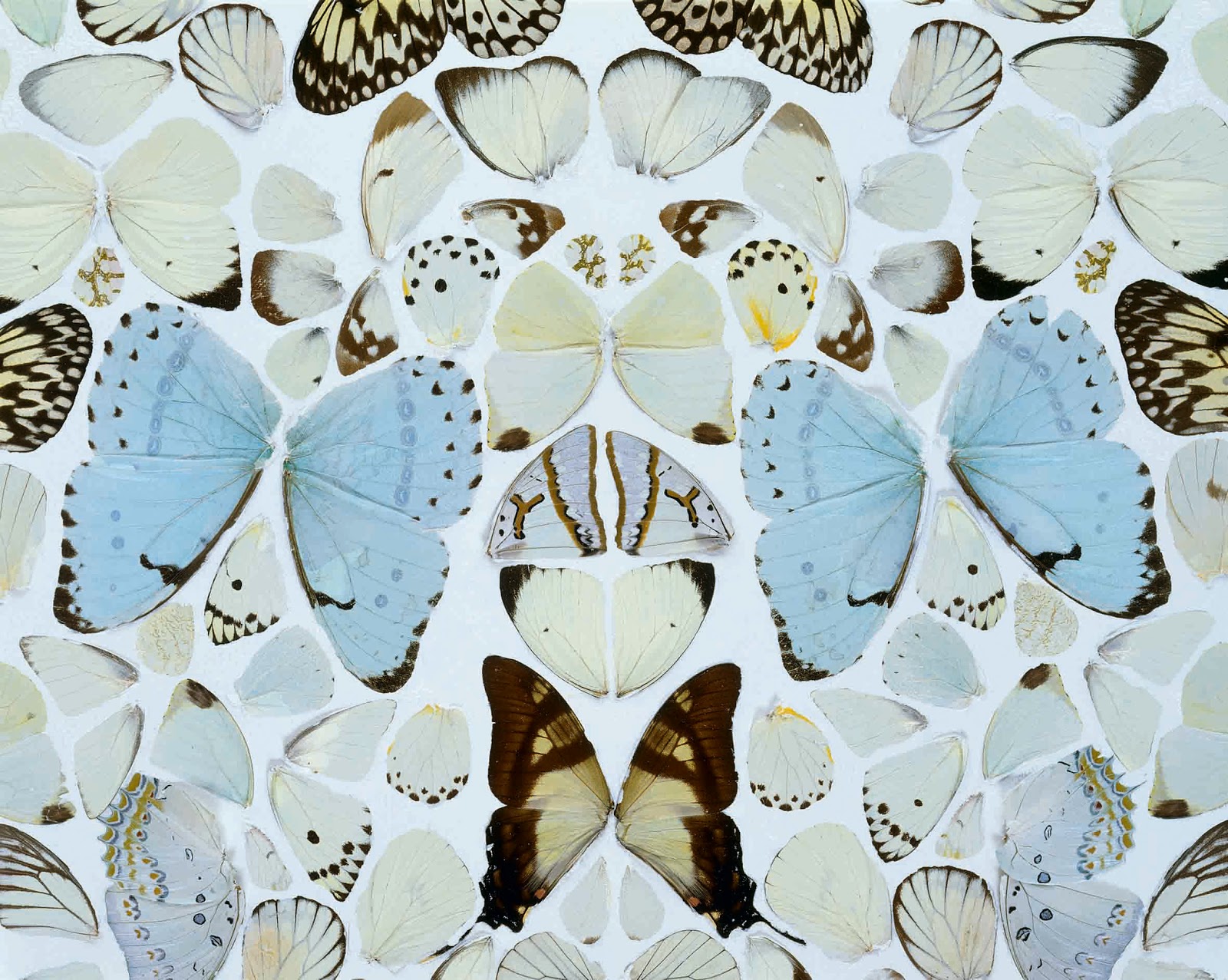04/04/12
Damien Hirst
Tate Modern
4 April – 9 September 2012
“I think that was the thing about our generation, we got our whole history of art from books. I remember at college they were saying to us, ‘You must go and actually see these works,’ and I remember thinking, ‘Why bother?’” explains Damien Hirst (born 1965) in an interview with the Director of the Tate, Nicholas Serota. And that is probably how a lot of people feel now about Hirst’s own works. Ubiquitous as they are, I certainly had the impression of knowing them all only too well, despite not having ever experienced them, as it were, in the flesh. In my case, however, that made me all the more excited to rectify this false memory, and, having now stood close enough to see my breath on the many vitrines, feel tempted to try blowing the balls from their precarious balances upon air jets above hairdryers and large coloured boxes, read the labels on the sides of medicine bottles and placebo pills, and see my own reflection in the mirrors set behind rows of diamonds, I do have to conclude that “bothering” is indeed worth it – even if, sceptical as many critics of Hirst’s work are, not for the experience of seeing the actual works themselves, then at least for the experience of seeing how others respond to them. As Chris Dercon, Director of Tate Modern, says: “We love to watch other people watch Damien Hirst.”

Whatever you think of him, it cannot be denied that Hirst is one of the most significant figures in British art from the last quarter of a century, bursting on to the scene back in 1988 when he curated Freeze, a show of his own and his fellow Goldsmiths students’ works in a disused warehouse. His own works on display included Edge (1988) and Row (1988), some of his very first spot paintings, painted directly on to the walls. These, along with the earliest itself, Spot Painting (1986), are included in this retrospective. It was around this time that Hirst says he realised he wouldn’t really fit into the art world if it remained as it was, and so, what to do? Get out there and change it!
Hirst is certainly a very prolific artist, and this show, his first major survey in the UK, has been described by the curatorial team as being “like a big cinema production; an architectural endeavour.” They had to be very selective, but, whilst the main focus of the exhibition is on the 10 years in which he established his artistic vocabulary, it also includes most of his seminal works, and a good representation of his main thematic categories.

One inevitable candidate for inclusion was The Physical Impossibility of Death in the Mind of Someone Living (1991) – Hirst’s shark suspended in formaldehyde – which, created with the intent of provoking some profound primal fear, actually, upon direct confrontation, is so bloodless and white, so drained and lifeless, so wrinkled, pallid and weak, that it is almost a humbling experience, and not at all fear-inspiring. Commissioned by Saatchi, this piece is nevertheless powerful in what it achieved, as it is seen as marking the start of the YBA era.
A Thousand Years (1990), another iconic work, and Hirst’s first vitrine, depicts the life cycle of flies, starting with maggots hatching in a white box, developing into flies, feeding on a severed cows head, and then going on to reproduce, and, in many cases, to die at the hands of a malevolently glowing insect-o-cutor. The blood from the cow’s head is so dark it’s almost black, and, as with the shark, it is a challenging task to convince oneself of the truth and accept this as something real. Hirst describes the creation of this work as his “Frankenstein moment,” as it was the first time he killed something in the name of art.
After flies, Hirst moved on to butterflies, with In and Out of Love (1991), which was created for his first solo exhibition in London. The two part installation consists of eight large butterfly “paintings,” which are not actually paintings at all, but dead butterflies mounted on large monochrome canvases behind glass, and a whole room full of butterflies, into which the visitor can enter. White canvases on the wall are adorned with pupae, hatching in the first few weeks of the show, and the resulting butterflies then feed on plants, sugar solution and fruit, whilst flitting from shoulder to shoulder, and note pad to hand bag, as the unsuspecting visitor becomes part of the living vitrine. The life span of the butterflies – all of which are far from your common or garden cabbage white – is, on average, two weeks, and so new supplies will be being imported regularly. As with the flies in A Thousand Years, the deceased exemplars will be left to mount up, adding to the work as time proceeds. Some might say that this is not art, and that you should go to a butterfly house if this is the experience you desire, and yes, it is indeed more about the experience than about “art,” but what is “art” if not an aesthetic experience? And this is certainly one to touch the senses.

Perhaps the most monumental animal work, however, is Mother and Child Divided (1993), a four-part installation, in which a cow and her calf are bisected and encased in vitrines of formaldehyde. From the external side view, the calf looks innocent and fluffy, almost serene, and from the inside, there is a compact precision to its innards, almost perfectly untouched. Its mother’s organs, however, appear, in stark contrast, worn and torn, like crumpled paper or fabric, dirty rags, and deflated balloons. Ageing and decay paradoxically preserved.
Hirst’s exploration of life and death extends beyond just the life cycles of insects and animals, to include also humans and symbolic references. An early memento mori, for example, is a photograph in which a teenage Hirst poses alongside a specimen head from the anatomy department at Leeds University, Dead Head (1991). His myriad works with cigarettes also stem from his view of the act of smoking as representing a “mini life cycle.”

“There are four important things in life: religion, love, art and science,” says Hirst. And these recur in many of his series as well. The Medicine Cabinets, for example, are representative both of science, but also give an oblique visualisation of the body, as the remedies contained are appropriate for different ailments and organs. The exhibition seems to be overrun with these cabinets, ranging from his first one, Sinner (1988), containing the personal prescriptions his grandmother gave to him before she died, through Pharmacy (1992), a large-scale installation filling an entire room, to Trinity – Pharmacology, Physiology, Pathology (2000), showcasing surgical teaching aids and implements. In some, packages and bottles are lined up neatly, in others, individual pills are laid out at angles, their colours echoing the patterns of the Spot Paintings. Whether or not this was deliberate, Hirst certainly exploits colour in a schematic and ordered way. As he explains to Serota, “the thing that was causing me the problems in painting was colour, finding a structure where I could lay it down, be in control of it rather than it controlling me.” And this is what the Spot series allowed him to do: arrange the colours in spots of uniform size and shape, laid out in a precise grid structure. His later Spin Paintings, however, seem to depart from this rigidity, with the colours being left to take charge and splash at whim across the circular canvases. Similarly, his recent return to the butterfly motif, arranged in kaleidoscopic, mandala-like forms to produce works reminiscent of stained glass windows (for example, Doorways to the Kingdom of Heaven, 2007), are also a panoply of colour.

Then, of course, there are the diamonds. No one can think of Hirst without thinking of these. The penultimate room contains the breathtaking Judgement Day (2009), a gold cabinet filled with 30,000 manufactured diamonds. Majestic, dazzling, stunning and awe-inspiring, the jewels refract the spectrum and reflect light, sending out rays of colour, again echoing the Spot Paintings and pills. In addition, the visitor sees himself reflected in the mirrors behind. “It’s definitely all about feeling like King Midas,” comments Hirst. On the opposite wall is a cabinet of cigarette butts, The Abyss (2008), arranged at angles, like semaphore code. The contrast between beauty and ugliness couldn’t be more blunt: “I like all those opposites. […] In an artwork I always try to say something and deny it at the same time.”
Finally (and that isn’t to say I have mentioned even a cross sample of the seventy plus works on display), the notorious skull, For the Love of God (2007), is being displayed in its own little black room in the Turbine Hall. (Entry to this is free, unlike the main exhibition upstairs, but it is only there until 24 June.) Made from a life-size platinum cast of an 18th century human skull, and encrusted with 8,601 flawless diamonds, inset with a 52.4 carat pink diamond in the centre of the forehead, this piece represents the pinnacle of the contemporary art world’s obsession with value and consumerism. In terms of Hirst himself, it takes us full circle from where he began, as a student in Leeds, jokily posing for the photo Dead Head, but also encapsulates how he has moved on, made money, played with concepts of value, and questioned life and death. It acts as both a symbol of death, but also a celebration of life. In Hirst’s own words: “Art’s about life and it can’t really be about anything else. There isn’t anything else.” Life is for living and making the most of, and, whether you love him or hate him for it, that is certainly something this artist has done. Don’t just read about him in the history books, come and judge for yourself.
Images:
Damien Hirst
Lullaby, the Seasons (detail)
2002
© Damien Hirst and Science Ltd. All rights reserved. DACS 2012
Photographed by Prudence Cuming Associates
Damien Hirst
The Physical Impossibility of Death in the Mind of Someone Living
1991
© Damien Hirst and Science Ltd. All rights reserved. DACS 2011
Photo: Photographed by Prudence Cuming Associates
Damien Hirst
Sympathy in White Major – Absolution II
2006
© Damien Hirst and Science Ltd. All rights reserved. DACS 2011.
Photo: Photographed by Prudence Cuming Associates
Damien Hirst
Pharmacy
1992
© Tate
Damien Hirst
Beautiful, childish, expressive, tasteless, not art, over simplistic, throw away, kid’s stuff, lacking integrity, rotating, nothing but visual candy, celebrating, sensational, inarguably beautiful painting (for over the sofa)
1996
© Damien Hirst and Science Ltd. All rights reserved. DACS 2011.
Photo: Photographed by Prudence Cuming Associates